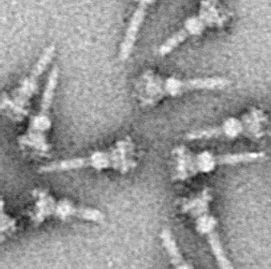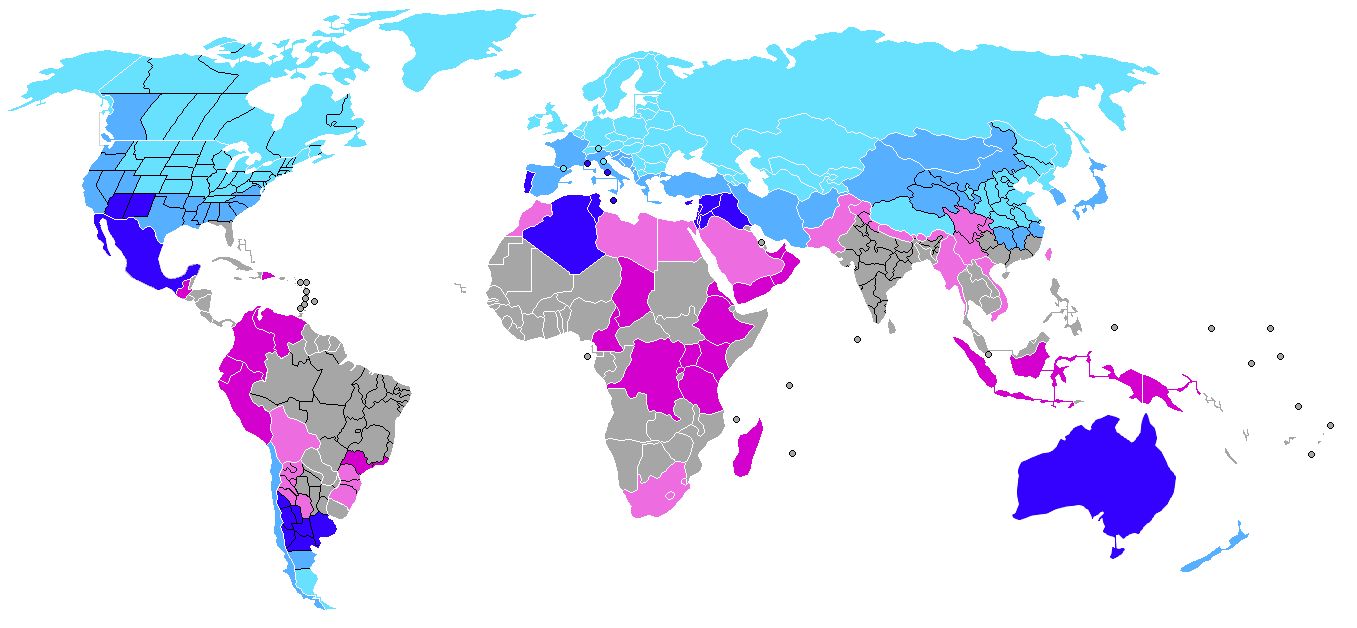|
Pseudomonas Syringae
''Pseudomonas syringae'' is a rod-shaped, Gram-negative bacterium with polar flagella. As a plant pathogen, it can infect a wide range of species, and exists as over 50 different pathovars, all of which are available to researchers from international culture collections such as the NCPPB, ICMP, and others. ''Pseudomonas syringae'' is a member of the genus ''Pseudomonas'', and based on 16S rRNA analysis, it has been placed in the ''P. syringae'' group. It is named after the lilac tree ('' Syringa vulgaris''), from which it was first isolated. A phylogenomic analysis of 494 complete genomes from the entire ''Pseudomonas'' genus showed that ''P. syringae'' does not form a monophyletic species in the strict sense, but a wider evolutionary group that also included other species as well, such as ''P. avellanae'', ''P. savastanoi'', ''P. amygdali'', and ''P. cerasi''. ''Pseudomonas syringae'' tests negative for arginine dihydrolase and oxidase activity, and forms the polymer levan ... [...More Info...] [...Related Items...] OR: [Wikipedia] [Google] [Baidu] |
European And Mediterranean Plant Protection Organization
The European and Mediterranean Plant Protection Organization (EPPO) is an intergovernmental organisation responsible for European cooperation in plant protection in the European and Mediterranean region. Founded on April 18th, 1951 and based in Paris, France, EPPO is the Regional Plant Protection Organization (RPPO) for Europe under the International Plant Protection Convention (IPPC). To meet its objectives to protect plants, strategize against the introduction and spread of dangerous pests, and to promote safe and effective control methods, EPPO develops international standards and recommendations, provides reporting services, participates in global discussions on plant health, EPPO hold regular expert working groups, and maintained EPPO codes. History Founded in 1951 and based in Paris, France, EPPO is the Regional Plant Protection Organization (RPPO) for Europe under the International Plant Protection Convention (IPPC). The intergovernmental organisation responsible for ... [...More Info...] [...Related Items...] OR: [Wikipedia] [Google] [Baidu] |
Siderophore
Siderophores (Greek: "iron carrier") are small, high-affinity iron- chelating compounds that are secreted by microorganisms such as bacteria and fungi. They help the organism accumulate iron. Although a widening range of siderophore functions is now being appreciated. Siderophores are among the strongest (highest affinity) Fe3+ binding agents known. Phytosiderophores are siderophores produced by plants. Scarcity of soluble iron Despite being one of the most abundant elements in the Earth's crust, iron is not readily bioavailable. In most aerobic environments, such as the soil or sea, iron exists in the ferric (Fe3+) state, which tends to form insoluble rust-like solids. To be effective, nutrients must not only be available, they must be soluble. Microbes release siderophores to scavenge iron from these mineral phases by formation of soluble Fe3+ complexes that can be taken up by active transport mechanisms. Many siderophores are nonribosomal peptides, although several are biosy ... [...More Info...] [...Related Items...] OR: [Wikipedia] [Google] [Baidu] |
Tomato
The tomato is the edible berry of the plant ''Solanum lycopersicum'', commonly known as the tomato plant. The species originated in western South America, Mexico, and Central America. The Mexican Nahuatl word gave rise to the Spanish word , from which the English word ''tomato'' derived. Its domestication and use as a cultivated food may have originated with the indigenous peoples of Mexico. The Aztecs used tomatoes in their cooking at the time of the Spanish conquest of the Aztec Empire, and after the Spanish encountered the tomato for the first time after their contact with the Aztecs, they brought the plant to Europe, in a widespread transfer of plants known as the Columbian exchange. From there, the tomato was introduced to other parts of the European-colonized world during the 16th century. Tomatoes are a significant source of umami flavor. They are consumed in diverse ways: raw or cooked, and in many dishes, sauces, salads, and drinks. While tomatoes are fruits� ... [...More Info...] [...Related Items...] OR: [Wikipedia] [Google] [Baidu] |
Nicotiana Benthamiana
''Nicotiana benthamiana'', colloquially known as benth or benthi, is a species of ''Nicotiana'' indigenous to Australia. It is a close relative of tobacco. A synonym for this species is ''Nicotiana suaveolens'' var. ''cordifolia'', a description given by George Bentham in '' Flora Australiensis'' in 1868. This was transferred to ''Nicotiana benthamiana'' by Karel Domin in ''Bibliotheca Botanica'' (1929), honoring the original author in the specific epithet. History The plant was used by people of Australia as a stimulant, containing nicotine and other alkaloids, before the introduction of commercial tobacco ('' N. tabacum'' and '' N. rustica''). Indigenous names for it include ''tjuntiwari'' and ''muntju''. It was first collected on the north coast of Australia by Benjamin Bynoe on a voyage of in 1837. Description The herbaceous plant is found amongst rocks on hills and cliffs throughout the northern regions of Australia. Variable in height and habit, the species may be ... [...More Info...] [...Related Items...] OR: [Wikipedia] [Google] [Baidu] |
Arabidopsis Thaliana
''Arabidopsis thaliana'', the thale cress, mouse-ear cress or arabidopsis, is a small flowering plant native to Eurasia and Africa. ''A. thaliana'' is considered a weed; it is found along the shoulders of roads and in disturbed land. A winter annual with a relatively short lifecycle, ''A. thaliana'' is a popular model organism in plant biology and genetics. For a complex multicellular eukaryote, ''A. thaliana'' has a relatively small genome around 135 megabase pairs. It was the first plant to have its genome sequenced, and is a popular tool for understanding the molecular biology of many plant traits, including flower development and light sensing. Description ''Arabidopsis thaliana'' is an annual (rarely biennial) plant, usually growing to 20–25 cm tall. The leaves form a rosette at the base of the plant, with a few leaves also on the flowering stem. The basal leaves are green to slightly purplish in color, 1.5–5 cm long, and 2–10 mm broad, wit ... [...More Info...] [...Related Items...] OR: [Wikipedia] [Google] [Baidu] |
Plant Disease Resistance
Plant disease resistance protects plants from pathogens in two ways: by pre-formed structures and chemicals, and by infection-induced responses of the immune system. Relative to a susceptible plant, disease resistance is the reduction of pathogen growth on or in the plant (and hence a reduction of disease), while the term disease tolerance describes plants that exhibit little disease damage despite substantial pathogen levels. Disease outcome is determined by the three-way interaction of the pathogen, the plant and the environmental conditions (an interaction known as the disease triangle). Defense-activating compounds can move cell-to-cell and systematically through the plant's vascular system. However, plants do not have circulating immune cells, so most cell types exhibit a broad suite of antimicrobial defenses. Although obvious ''qualitative'' differences in disease resistance can be observed when multiple specimens are compared (allowing classification as “resistant” o ... [...More Info...] [...Related Items...] OR: [Wikipedia] [Google] [Baidu] |
USDA ARS
The Agricultural Research Service (ARS) is the principal in-house research agency of the United States Department of Agriculture (USDA). ARS is one of four agencies in USDA's Research, Education and Economics mission area. ARS is charged with extending the nation's scientific knowledge and solving agricultural problems through its four national program areas: nutrition, food safety and quality; animal production and protection; natural resources and sustainable agricultural systems; and crop production and protection. ARS research focuses on solving problems affecting Americans every day. The ARS Headquarters is located in the Jamie L. Whitten Building on Independence Avenue in Washington, D.C. and the headquarters staff is located at the George Washington Carver Center (GWCC) in Beltsville, Maryland. For 2018, its budget was $1.2 billion. Mission ARS conducts scientific research for the American public. Their main focus is on research to develop solutions to agricultural pro ... [...More Info...] [...Related Items...] OR: [Wikipedia] [Google] [Baidu] |
National Science Foundation
The National Science Foundation (NSF) is an independent agency of the United States government that supports fundamental research and education in all the non-medical fields of science and engineering. Its medical counterpart is the National Institutes of Health. With an annual budget of about $8.3 billion (fiscal year 2020), the NSF funds approximately 25% of all federally supported basic research conducted by the United States' colleges and universities. In some fields, such as mathematics, computer science, economics, and the social sciences, the NSF is the major source of federal backing. The NSF's director and deputy director are appointed by the President of the United States and confirmed by the United States Senate, whereas the 24 president-appointed members of the National Science Board (NSB) do not require Senate confirmation. The director and deputy director are responsible for administration, planning, budgeting and day-to-day operations of the foundation, whi ... [...More Info...] [...Related Items...] OR: [Wikipedia] [Google] [Baidu] |
Cornell University
Cornell University is a private statutory land-grant research university based in Ithaca, New York. It is a member of the Ivy League. Founded in 1865 by Ezra Cornell and Andrew Dickson White, Cornell was founded with the intention to teach and make contributions in all fields of knowledge—from the classics to the sciences, and from the theoretical to the applied. These ideals, unconventional for the time, are captured in Cornell's founding principle, a popular 1868 quotation from founder Ezra Cornell: "I would found an institution where any person can find instruction in any study." Cornell is ranked among the top global universities. The university is organized into seven undergraduate colleges and seven graduate divisions at its main Ithaca campus, with each college and division defining its specific admission standards and academic programs in near autonomy. The university also administers three satellite campuses, two in New York City and one in Educatio ... [...More Info...] [...Related Items...] OR: [Wikipedia] [Google] [Baidu] |
Type III Secretion System
The type III secretion system (T3SS or TTSS), also called the injectisome, is one of the bacterial secretion systems used by bacteria to secrete their effector proteins into the host's cells to promote virulence and colonisation. The T3SS is a needle-like protein complex found in several species of pathogenic gram-negative bacteria. Overview The term Type III secretion system was coined in 1993. This secretion system is distinguished from at least five other secretion systems found in gram-negative bacteria. Many animal and plant associated bacteria possess similar T3SSs. These T3SSs are similar as a result of divergent evolution and phylogenetic analysis supports a model in which gram-negative bacteria can transfer the T3SS gene cassette horizontally to other species. The most researched T3SSs are from species of '' Shigella'' (causes bacillary dysentery), ''Salmonella'' (typhoid fever), ''Escherichia coli'' (Gut flora, some strains cause food poisoning), '' Vibrio'' (gas ... [...More Info...] [...Related Items...] OR: [Wikipedia] [Google] [Baidu] |
Snow
Snow comprises individual ice crystals that grow while suspended in the atmosphere An atmosphere () is a layer of gas or layers of gases that envelop a planet, and is held in place by the gravity of the planetary body. A planet retains an atmosphere when the gravity is great and the temperature of the atmosphere is low. ...—usually within clouds—and then fall, accumulating on the ground where they undergo further changes. It consists of frozen crystalline water throughout its life cycle, starting when, under suitable conditions, the ice crystals form in the atmosphere, increase to millimeter size, precipitate and accumulate on surfaces, then metamorphose in place, and ultimately melt, slide or Sublimation (phase transition), sublimate away. Snowstorms organize and develop by feeding on sources of atmospheric moisture and cold air. Snowflakes Nucleation, nucleate around particles in the atmosphere by attracting supercooling, supercooled water droplets, which ... [...More Info...] [...Related Items...] OR: [Wikipedia] [Google] [Baidu] |







